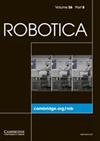Dynamic modeling and simulation of a torque-controlled spatial quadruped robot
IF 2.7
4区 计算机科学
Q3 ROBOTICS
引用次数: 0
Abstract
Evolution has shown that legged locomotion is most adequate for tasks requiring versatile movement on land, allowing animals to traverse a wide variety of environments ranging from natural terrain to artificial, man-made landscapes with great ease. By employing well-designed control schemes, this ability could be replicated for legged robots, enabling them to be used in critical situations that still pose great danger to human integrity, such as search and rescue missions, inspection of hazardous areas, and even space exploration. This work characterizes the quadruped robot and contact dynamics that will compose our in-house simulator to be used for prototyping locomotion control schemes applied to quadruped robots. The proposed simulator computes the robot dynamics using the Recursive Newton-Euler and Composite-Rigid-Body algorithms with a few modifications to make certain aspects relevant for contact detection and control more easily accessible; furthermore, a compliant contact force method alongside stick-slip friction modeled the contact dynamics. To allow the robot to move, a simple PD-independent joint controller was implemented to track a desired leg trajectory. With the same robot and controller implemented using the MuJoCo simulation software, this work evaluates the proposed simulator by comparing characteristic locomotion signals such as the trunk pose and the ground reaction forces. Results showed similar behavior for both simulators, especially with regard to the contact detection, despite the significantly different contact models. Lastly, final remarks to enhance our simulator’s performance are suggested to be explored in future works.扭矩控制空间四足机器人的动态建模与仿真
进化论表明,腿部运动最适用于需要在陆地上进行多功能运动的任务,使动物能够轻松穿越从自然地形到人造景观的各种环境。通过采用精心设计的控制方案,腿部机器人也能复制这种能力,使其能够用于对人类完整性仍有极大危险的关键场合,如搜救任务、危险区域检查,甚至太空探索。这项工作描述了四足机器人和接触动力学的特点,它将构成我们的内部模拟器,用于原型开发应用于四足机器人的运动控制方案。拟议的模拟器使用递归牛顿-欧拉算法和复合刚体算法计算机器人动力学,并进行了一些修改,使接触检测和控制的某些相关方面更容易获得;此外,顺应接触力方法与粘滑摩擦力一起模拟了接触动力学。为了使机器人能够移动,我们实施了一个简单的不依赖于 PD 的关节控制器,以跟踪所需的腿部轨迹。本研究使用 MuJoCo 仿真软件实现了相同的机器人和控制器,并通过比较躯干姿势和地面反作用力等运动特征信号来评估所提出的模拟器。结果表明,尽管接触模型大相径庭,但两个模拟器的表现相似,尤其是在接触检测方面。最后,我们建议在今后的工作中探讨如何提高模拟器的性能。
本文章由计算机程序翻译,如有差异,请以英文原文为准。
求助全文
约1分钟内获得全文
求助全文
来源期刊

Robotica
工程技术-机器人学
CiteScore
4.50
自引率
22.20%
发文量
181
审稿时长
9.9 months
期刊介绍:
Robotica is a forum for the multidisciplinary subject of robotics and encourages developments, applications and research in this important field of automation and robotics with regard to industry, health, education and economic and social aspects of relevance. Coverage includes activities in hostile environments, applications in the service and manufacturing industries, biological robotics, dynamics and kinematics involved in robot design and uses, on-line robots, robot task planning, rehabilitation robotics, sensory perception, software in the widest sense, particularly in respect of programming languages and links with CAD/CAM systems, telerobotics and various other areas. In addition, interest is focused on various Artificial Intelligence topics of theoretical and practical interest.
 求助内容:
求助内容: 应助结果提醒方式:
应助结果提醒方式:


